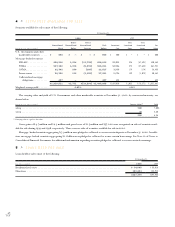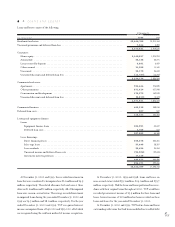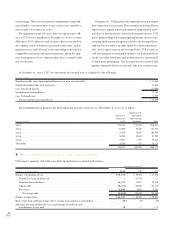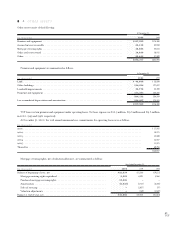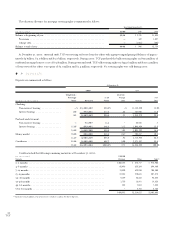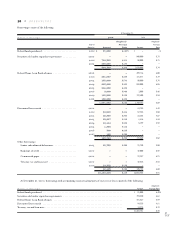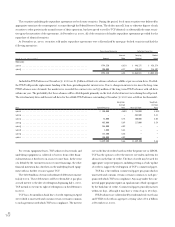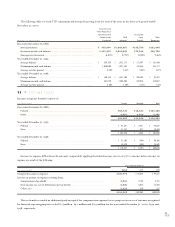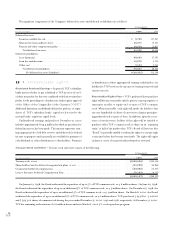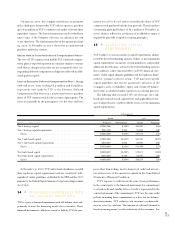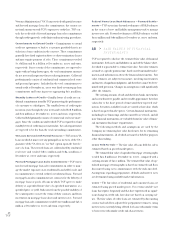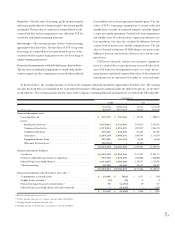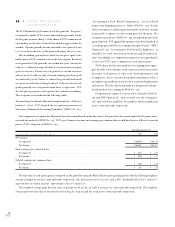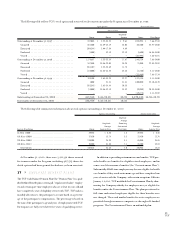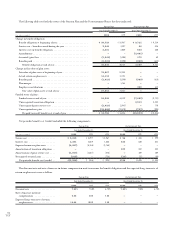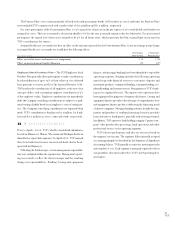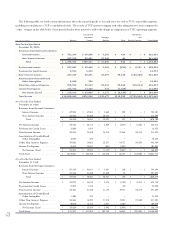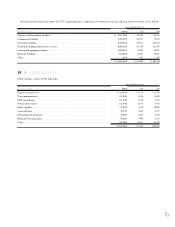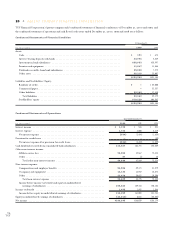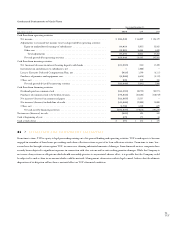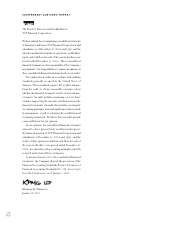TCF Bank 2000 Annual Report Download - page 58
Download and view the complete annual report
Please find page 58 of the 2000 TCF Bank annual report below. You can navigate through the pages in the report by either clicking on the pages listed below, or by using the keyword search tool below to find specific information within the annual report.
Veterans Administration (“VA”) loans serviced with partial recourse
and forward mortgage loan sales commitments, the contract or
notional amount exceeds TCF’s exposure to credit loss. TCF con-
trols the credit risk of forward mortgage loan sales commitments
through credit approvals, credit limits and monitoring procedures.
Commitments to Extend Credit – Commitments to extend
credit are agreements to lend to a customer provided there is no
violation of any condition in the contract. These commitments
generally have fixed expiration dates or other termination clauses
and may require payment of a fee. These commitments totaled
$1.1 billion and $1.2 billion at December 31, 2000 and 1999,
respectively. Since certain of the commitments are expected to
expire without being drawn upon, the total commitment amounts
do not necessarily represent future cash requirements. Collateral
predominantly consists of residential and commercial real estate
and personal property. Included in the total commitments to
extend credit at December 31, 2000 were fixed-rate mortgage loan
commitments and loans in process aggregating $27.5 million.
Standby Letters of Credit – Standby letters of credit are con-
ditional commitments issued by TCF guaranteeing the performance
of a customer to a third party. The standby letters of credit expire
in various years through the year 2005 and totaled $28.8 million
and $22 million at December 31, 2000 and 1999, respectively.
Collateral held primarily consists of commercial real estate mort-
gages. Since the conditions under which TCF is required to fund
standby letters of credit may not materialize, the cash requirements
are expected to be less than the total outstanding commitments.
VA Loans Serviced with Partial Recourse – TCF services VA
loans on which it must cover any principal loss in excess of the VA’s
guarantee if the VA elects its “no-bid” option upon the foreclo-
sure of a loan. The serviced loans are collateralized by residential
real estate and totaled $182.1 million and $184.5 million at
December 31, 2000 and 1999, respectively.
Forward Mortgage Loan Sales Commitments – TCF enters
into forward mortgage loan sales commitments in order to man-
age the market exposure on its residential loans held for sale and
its commitments to extend credit for residential loans. Forward
mortgage loan sales commitments are contracts for the delivery of
mortgage loans or pools of loans in which TCF agrees to make
delivery at a specified future date of a specified instrument, at a
specified price or yield. Risks arise from the possible inability of
the counterparties to meet the terms of their contracts and from
movements in mortgage loan values and interest rates. Forward
mortgage loan sales commitments totaled $121.7 million and $46.3
million at December 31, 2000 and 1999, respectively.
Federal Home Loan Bank Advances – Forward Settle-
ments – TCF enters into forward settlements of FHLB advances
in the course of asset and liability management and to manage
interest rate risk. Forward settlements of FHLB advances totaled
$300 million and $189 million at December 31, 2000 and 1999,
respectively.
15 >FAIR VALUES OF FINANCIAL
INSTRUMENTS
TCF is required to disclose the estimated fair value of financial
instruments, both assets and liabilities on and off the balance sheet,
for which it is practicable to estimate fair value. Fair value estimates
are made at a specific point in time, based on relevant market infor-
mation and information about the financial instruments. Fair
value estimates are subjective in nature, involving uncertainties
and matters of significant judgment, and therefore cannot be deter-
mined with precision. Changes in assumptions could significantly
affect the estimates.
The carrying amounts of cash and due from banks, investments
and accrued interest payable and receivable approximate their fair
values due to the short period of time until their expected real-
ization. Securities available for sale are carried at fair value, which
is based on quoted market prices. Certain financial instruments,
including lease financings and discounted lease rentals, and all
non-financial instruments are excluded from fair value of finan-
cial instrument disclosure requirements.
The following methods and assumptions are used by the
Company in estimating fair value disclosures for its remaining
financial instruments, all of which are issued or held for purposes
other than trading.
Loans Held for Sale – The fair value of loans held for sale is
estimated based on quoted market prices.
The estimated fair value of capitalized mortgage servicing rights
totaled $49.8 million at December 31, 2000, compared with a
carrying amount of $40.1 million. The estimated fair value of cap-
italized mortgage servicing rights is based on estimated cash flows
discounted using rates commensurate with the risks involved.
Assumptions regarding prepayments, defaults and interest rates
are determined using available market information.
Loans – The fair values of residential and consumer loans are
estimated using quoted market prices. For certain variable-rate
loans that reprice frequently and that have experienced no signif-
icant change in credit risk, fair values are based on carrying val-
ues. The fair values of other loans are estimated by discounting
contractual cash flows adjusted for prepayment estimates, using
interest rates currently being offered for loans with similar terms
to borrowers with similar credit risk characteristics.
56
TCF


